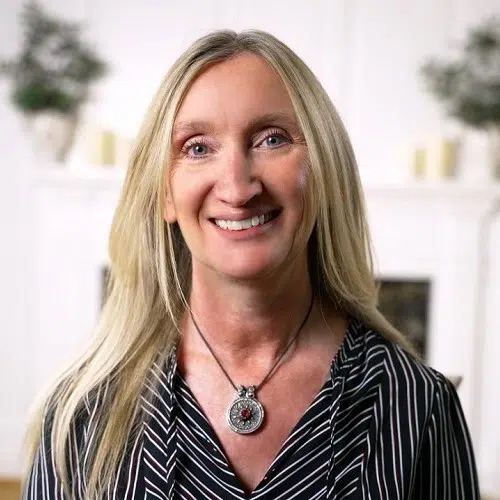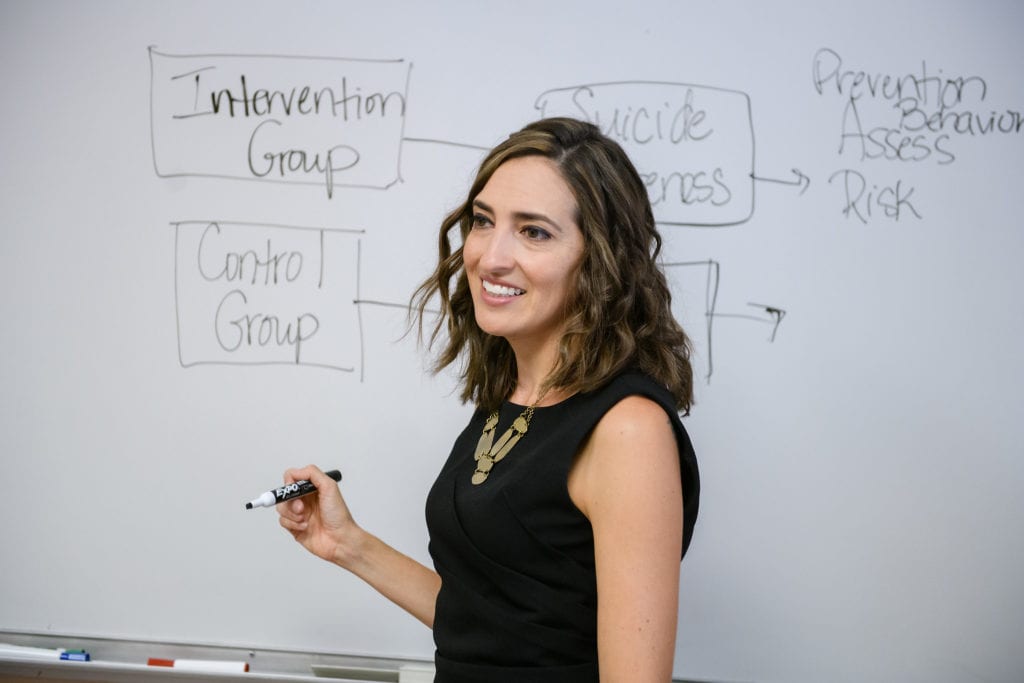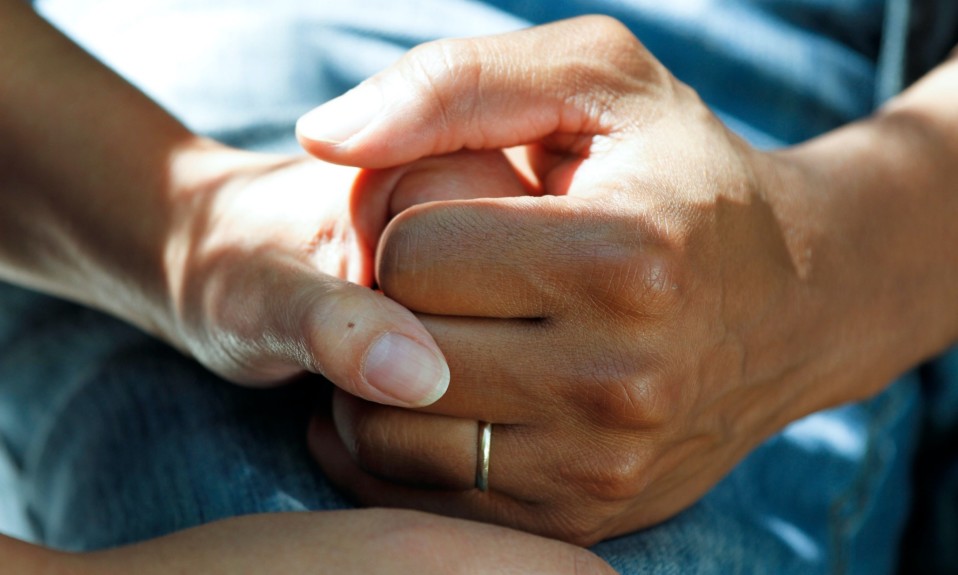Two disorders that feed one another—and can involve a host of other behavioral issues—present one of the biggest challenges in the field of addiction treatment
By Mark Mravic
It’s a grim fact of life that deeply traumatic events are not uncommon. Criminal attack, natural disaster, war, domestic violence, child abuse, sexual assault—such experiences, occurring either suddenly or as part of a prolonged and chronic pattern, disrupt normal life and can generate feelings of unease, danger and mistrust. And as any addiction treatment care worker will tell you, people exposed to such trauma often turn to alcohol or drugs to help them deal with that emotional pain and disruption. In serious and prolonged cases, the behavior develops into one of the thorniest conditions in the treatment field: the co-occurrence of post-traumatic stress disorder (PTSD) and substance use disorder (SUD).
“We can see exposure to traumatic events as part of normal human experience,” says Heidi Zinzow, PhD, a professor in the Department of Psychology at Clemson University and a licensed clinical psychologist with expertise in trauma. “But sometimes people have a host of symptoms in response that become problematic for them.”
That cluster of symptoms—sometimes called Complex PTSD—creates challenges for treatment and recovery. But successful strategies are available, and people do recover.
The Prevalence of PTSD and SUD
Historically, PTSD was closely associated with soldiers in wartime—the condition was called “shell shock” in World War I and “combat fatigue” in World War II, before being recognized in 1980 as the condition we know today. It’s no surprise, then, that the U.S. Department of Veterans Affairs (VA) houses the National Center for PTSD. One of the world’s leading centers for PTSD research and education, it provides a wealth of information for patients and providers on PTSD and how it relates to SUD and other disorders.
According to the VA, about 6 out of every 100 Americans will have PTSD at some point in their lives, and during a given year about 12 million Americans actively have the disorder. Women, the VA notes, are twice as likely as men to have PTSD during their lives. Studies show that overall, while men are more likely to experience traumatic events, women are more likely to develop PTSD. Males’ exposures more often involve accidents, disasters and non-sexual violence; women are more likely to experience sexual assault and child sexual abuse. Researchers speculate that the latter types of exposure may cause more emotional suffering, explaining the higher rates of PTSD in women.
Not all people develop PTSD in response to trauma exposure—in fact, research puts the number at around one-third. (And why some develop it and others don’t is a subject of study and speculation.) Additionally, not all people with PTSD have an SUD. PTSD can bring on problematic substance use, but substance use can itself precede PTSD and perpetuate it. Complicated, right?
What is universally recognized is that untreated trauma underpins a good deal of substance use disorder. “Those can be early childhood experiences, catastrophic events, personal assaults,” says Trish Caldwell, senior vice president of clinical services at Recovery Centers of America and a leading educator on trauma and SUD. “In the world of substance use, we say the substance isn’t the problem—it’s the solution. Someone is looking to solve something, and a lot of that is untreated trauma.”

Caldwell notes that research puts a secondary trauma diagnosis at 85% of SUD sufferers. One U.K. study of people undergoing inpatient treatment for SUD found an even higher prevalence: 94% of SUD patients in the study reported having one or more traumatic experiences that would fall under Criterion A for PTSD; 38.5% of the patients met the full criteria for a diagnosis of PTSD; and 51.9% had the disorder at some point in their lives.
And while alcohol is the substance most often associated with PTSD, other drugs can be involved as well—even stimulants. A study of people being treated for cocaine dependence found that participants had experienced a large number of lifetime traumatic events—a mean of nearly 6, far more than the average. More than 20% in the study met the criteria for PTSD.
Links between trauma exposure and SUD are well-established. The National Survey of Adolescents found that teens who had experienced physical or sexual abuse or assault were three times more likely to report substance misuse than those without a history of trauma. Surveys of teens receiving treatment for substance use show that more than 70% had a history of trauma exposure.
Social, racial and economic elements are also factors. While trauma exposure and problematic responses cut across all groups, Clemson’s Zinzow says, “There are healthcare disparities, as there are with so many of our healthcare problems. Minority populations are more at risk for a variety of reasons, including lack of access to resources, community violence exposure and living situations.” And, she adds, “the stress of discrimination and marginalization in our society compounds trauma response. The distrust in formal healthcare systems, which creates barriers to care—these are all factors that make our minority populations at greater risk for more psychological symptoms or problems in response to trauma.”
Symptoms of PTSD
PTSD symptoms can begin immediately after a traumatic event but sometimes don’t appear for months or years afterward. Symptoms, as noted by the National Center for PTSD, include:
- Reliving the event. Flashbacks, nightmares or triggers such as sights, sounds and smells that bring the event back into the mind
- Avoidance. Isolating oneself from potential exposure to things that evoke memories of the traumatic event or experience. Avoidance can also involve attempts to block out thoughts or discussion of the traumatic exposure
- Negative thoughts and feelings. These can manifest themselves as emotional numbness, inability to engage, forgetfulness, a sense that the world is unsafe, lack of trust in others, guilt, shame or self-blame
- Hyperarousal. Those with PTSD can feel on edge, jittery and always on the alert for potential danger. This can be accompanied by sudden outbursts of anger or irritability, difficulty sleeping or concentrating, being easily startled, or risky behavior (which may also be a form of avoidance)
The most common idea is that substance use is self-medication for PTSD symptoms. “People are trying to cope with the symptoms of hyperarousal, such as being on guard or hypervigilant, or with experiences of nightmares and heightened distress,” says Zinzow. Through substance use, she says, people “will try to numb out that response, or help themselves sleep or disengage.”
The SUD response can also be seen as a form of avoidance. “Since avoidance is one of the hallmark symptoms of PTSD, we can conceptualize substances as another form of avoidance—that I can’t handle confronting this trauma or thinking about it, so I’m going to get away from these painful experiences by using a substance,” Zinzow says.
“A substance abusing lifestyle might predispose individuals to experience traumatic events.”
—U.K. research study
Another hypothesized linkage between PTSD and SUD is that shared neurological, biological or temperamental vulnerabilities may make some people predisposed to develop certain mental health problems. Upon exposure to trauma, these people will be more likely to develop pathological responses. Such predisposition would help explain why some people develop PTSD after traumatic exposure, with or without SUD, and others do not.
And there’s a which-comes-first scenario as well. People with SUD are more likely to be exposed to trauma as a result of their substance use—for instance, an unhoused person with SUD may be vulnerable to physical assault or robbery; someone with problematic alcohol use is more likely to have a car accident. As one study summarized the dynamic, “Avoidance of trauma reminders and associated distress may be achieved by the use of drugs and alcohol; alternatively, a substance abusing lifestyle might predispose such individuals to experience traumatic events.”
Because of such frequent comorbidity, researchers and clinicians emphasize the importance of assessing not just PTSD among people with SUD, but also SUD among those exhibiting trauma symptoms.
“Simple” vs. “Complex” Trauma
Is there a distinction between simple, or typical, trauma and complex trauma? In a way, it depends on where you are. The 5th edition of the Diagnostic and Statistical Manual of Mental Disorders (DSM-5), the standard mental health handbook in the U.S., doesn’t distinguish between typical PTSD and complex trauma. However, in 2018 the World Health Organization (WHO) Classification of Diseases (ICD-11) recognized Complex PTSD as a distinct, though obviously related, condition.
According to the WHO, essential features of Complex PTSD include:
- Exposure to an event or series of events of an extremely threatening or horrific nature, most commonly prolonged or repetitive events from which escape is difficult or impossible
- Development of core PTSD symptoms, including re-experiencing the event, avoidance behavior and hypervigilance
- Severe and pervasive problems in affect regulation, which can include heightened emotional reactions, violent outbursts, reckless behavior or emotional numbing
- Persistent difficulties in sustaining relationships and feeling close to others
- Significant impairment in personal, family, educational, social and occupational or other areas of functioning
Additional clinical symptoms of Complex PTSD, according to ICD-11, include:
- Suicidal ideation and behavior
- Substance misuse
- Depressive symptoms
- Psychotic symptoms
- Somatic complaints
Symptoms of Complex PTSD, the WHO says, are generally more severe and persistent than PTSD, and prolonged exposure, especially in early childhood, brings a greater risk of developing Complex PTSD.
In the U.S, “it’s not something that’s actually a distinction in our book of psychological disorders, that there’s the simple versus complex [trauma],” says Zinzow. “But within the research literature, there’s been more recent investigation into those two types of trauma response.”
People’s experience of trauma has two components: the exposure to the event itself, and the response. A majority of people will experience a traumatic event at some point in their lives—a car accident, a natural disaster, physical violence. If there is a problematic response to such exposure, it’s more typically acute stress disorder, in which symptoms resolve over the course of a month. If they continue for longer, the diagnosis becomes PTSD. And the suite of other potential disorders compounds the complexity.
“One way you could think about defining complex trauma is single versus multiple events. But it can also be in terms of people’s responses to trauma, which can range from less severe to more severe or less complex to more complex in terms of comorbidities.”
—Heidi Zinzow, Clemson University
“There are a lot of different symptom clusters that comprise post-traumatic stress disorder,” Zinzow says. “And in addition, people experience other reactions to trauma that constitute other psychological disorders”—not just substance use disorders, but depression, anxiety and more.
So rather than a clear line between “simple” and “complex” trauma, it’s perhaps more a continuum, involving factors such as the persistence and severity of exposure, and the accumulation and persistence of symptoms. “One way you could think about defining complex trauma is single versus multiple events,” says Zinzow. “But it can also be in terms of people’s responses to trauma, which can range from less severe to more severe or less complex to more complex in terms of comorbidities and types of symptoms they’re experiencing.” In addition, she says, “Interpersonal violence, like repeated exposure to child abuse or sexual assaults or domestic violence, sometimes combat—these interpersonal forms of violence are more likely to be associated with those kinds of complex responses.”
The Physiology of Trauma and SUD
Just as prolonged, chronic use of alcohol or drugs can cause physiological changes in the brain, repeated exposure to traumatic experiences can alter our neurobiology.
The body has a clearly evolved response to danger. Exposure to physical threats triggers the “fight or flight” response in the amygdala, the brain’s fear center. What ensues is a complex interplay of brain biology and neurochemistry, centered on the hypothalamic-pituitary-adrenal axis. Hormones such as adrenaline and cortisol are pumped out, making us hyperalert, increasing blood pressure, heart rate and breathing, and creating a sense of alarm. Eventually, the body gradually shuts that response down and returns the system to baseline. We feel calm.
But when that system is engaged repeatedly or in a chronic fashion—for instance, in experiences of war, prolonged child abuse or domestic violence—it becomes dysregulated. Cortisol, which curbs executive function and other processes that would be non-essential or harmful in a fight-or-flight scenario, goes out of balance, as do other hormones such as serotonin and dopamine. These physiological changes manifest themselves behaviorally in the symptoms that make up PTSD.
There’s also a physiological underpinning for substance use with PTSD. People suffering chronic exposure to trauma may turn to alcohol and other substances to try to shut down the fear response and blunt the sense of overarousal. But that use can become self-reinforcing. “[Substance use] releases dopamine, which is part of our reward systems,” Zinzow notes. “So it becomes a reward-seeking behavior in addition to an avoidance behavior. Anything that relieves pain and suffering, we are more likely to engage in over and over again. The substance use plays its part in that kind of behavioral response to stress.”
Diagnosing Trauma and SUD
RCA’s Caldwell has been treating substance use and trauma for more than 25 years, as well as training clinicians and other providers on best practices for such treatment. She notes that an initial assessment of a patient seeking care for SUD should look to identify potential underlying trauma symptoms: “You’re going to be asking questions that allow for you to see if there was any history [of trauma], doing a full inventory in regard to their childhood experiences, what their life has been like as they’ve gone through the years. And that sometimes highlights experiences that might increase the likelihood of having PTSD.”
“There needs to be a respect that [trauma care] is hard to do, and it can engender further harm if not done sensitively.”
—Heidi Zinzow
Clinicians who suspect PTSD can use further tools such as the Trauma History Questionnaire, the PTSD Checklist and the Clinically Administered PTSD Scale. It should be noted that the questions on these assessments can be quite probing and graphic, and may themselves potentially trigger stress responses. Questions on the Trauma History Questionnaire, for instance, include:
- “Have you ever seen someone seriously injured or killed? (If yes, please specify who)”
- “Has anyone ever made you have intercourse or oral or anal sex against your will? (If yes, please indicate nature of relationship with person [e.g., stranger, friend, relative, parent, sibling])”
- “Has anyone, including family members or friends, ever attacked you with a gun, knife or some other weapon?”
Zinzow emphasizes the sensitivity clinicians must have when assessing for trauma, while at the same time “not being afraid to talk about traumatic experiences or events, or treating people as if they are fragile. Because we don’t want to also reinforce too much avoidance of talking about trauma or further stigmatize it. So it’s a delicate balancing act of being able to talk about these events, but in a sensitive way that doesn’t further harm or re-victimize people.
“There needs to be a respect that [trauma care] is hard to do, and it can it can engender further harm if not done sensitively.”
Treating Complex Trauma and Addiction
Treatment for co-occurring PTSD and substance use can itself be a complex matter, since there are often additional disorders such as anxiety and depression, as well as other behavioral health and interpersonal issues, that need to be addressed.
The most effective empirically supported treatment for PTSD, Zinzow says, is cognitive behavioral therapy. It’s an umbrella term that encompasses a wide variety of therapies but has two essential components—the cognitive element works to change people’s thought patterns, and the behavioral piece works to alter problem behaviors. The therapies are targeted, skills-oriented and focused on changing particular patterns of thought, feeling and behavior.
“It’s almost like taking a class,” Zinzow says. “You’re teaching people skills that they can then employ in their lives, and rehearse and take with them.”
She also notes that there are some combined treatments “where two types of interventions are integrated for people, and we see that treating the PTSD actually helps to reduce urges, cravings and engaging in substance use. So that supports that self-medication hypothesis.”
Therapies for SUD alongside PTSD can include:
- Motivational interviewing—helping people evaluate the pros and cons of their behavior
- Stimulus control—helping people change their environmental keys and triggers for substance use
- Interpersonal skills—drink or substance refusal, assertive communication
- Mindfulness—staying present in the moment, with non-judgmental awareness
While talk-related PTSD therapies target the thinking part of the brain, it’s also important to address the “action” part, the limbic system where the fight-or-flight response occurs and where trauma-related physiological changes take place. Mindfulness and meditation play an important role in the ability to “tame the brain,” as Caldwell puts it, as do activities such as art therapy, music therapy, yoga, hiking and kickboxing—“all of these things that go directly after the physiological experience,” says Caldwell.
“When we’re working with somebody struggling with substance use disorder, our priority is their sobriety. And sometimes opening up something where they don’t have the capacity to get themselves regulated can undermine their recovery.”
—Trish Caldwell
One treatment that has been effective for PTSD is exposure therapy, which involves presenting the patient with distressing cues or memories, or having them relive or retell the traumatic event repeatedly until it stops eliciting the stress response. In vivo exposure involves putting patients into real-life situations that remind them of the event, repeating it until the fear response is extinguished. “A lot of what we do in treatment is reduce the avoidance and approach things over and over again,” Zinzow says, “until the person can reduce the fear response and gain a sense of competence and mastery in approaching these types of situations and thoughts.”
As with anything to do with trauma, balance and sensitivity are required; exposure therapy, for instance, may not be the best approach for someone in the early stages of treatment for co-occurring SUD and PTSD. “When we’re working with somebody struggling with substance use disorder,” says RCA’s Caldwell, “our priority is their sobriety. And sometimes opening up something where they don’t have the capacity to get themselves regulated can undermine their recovery.”
That’s where the continuum of care makes a difference. “Coming into an inpatient treatment facility is the beginning of a very long journey for a fulfilling, lifelong, meaningful recovery,” Caldwell says. “We want to be able to stabilize your substance use, make sure that you are medically monitored and able to appropriately step away from the substances of choice.”
Once that’s established, she says, “that’s where you’re going to be able to work on some of those harder issues. That’s where you’re going to be able to dive more into some of the narratives and the trauma work.” She compares it to building a house—you have to start with the tools.
In addition to behavioral therapies, other treatments for PTSD can include Eye Movement Desensitization and Reprocessing (EMDR), though that is controversial, since its mechanisms are not well-understood; and medications for depression, which can reduce PTSD symptoms in some cases. Promising research into the effectiveness of psychedelics combined with guided therapy for PTSD is ongoing. Such research, Caldwell says, “highlights the need and the demand for us to continue to think outside of the box.”
Trauma-Informed Care
All of those sensitivities are rolled into the concept of trauma-informed care, now widely recognized as an essential element in SUD and PTSD treatment.
Zinzow stresses the importance for clinicians, healthcare workers, educators and others who interact with trauma-exposed populations “to understand the various manifestations of traumatic stress, what that might look like, and be sensitive to the fact that people may have been exposed to trauma in their past, to treat people sensitively in a way that is not going to make them further vulnerable to distress.”

For instance, she says, because of past experiences that have caused them to lose trust, someone might experience distress upon being touched or when asked to close their eyes. A person might even need a private room or safe space where they feel less triggered. It’s vital, Zinzow says, to “give people the opportunity to feel empowered in these different situations, to make their own choices—to not have things happening to their bodies without their consent or knowledge. Because that can be very distressing for someone who’s experienced trauma.”
Caldwell conducts training with RCA colleagues, online through RCA Academy and with external providers—emergency room physicians, inpatient treatment facilities, therapists, primary care physicians and others—to bring an awareness of the vital importance of trauma-informed sensitivity in SUD treatment. As she says, “We are working with an individual who is asking for help for one of the most difficult things for them to overcome. The more we can educate ourselves in this field, the more we can come together to be a part of this community solution.”
What Does Recovery Look Like?
The dynamics of trauma and SUD—the range of traumatic experiences, responses, substances and comorbidities—present obvious challenges and make recovery highly individualized. And while behavioral therapies are meant to be time-limited—to set people up with skills and tools that they can go out and apply in their lives—there’s no common timetable for recovery. “Some of our patients are 20 miles into the forest [when they begin],” says Caldwell, “and some are seven miles.”
“Recovery isn’t about getting rid of [troubling] thoughts. Recovery is about learning how to manage them when you have them.”
—Trish Caldwell
Importantly, recovery from PTSD doesn’t involve the elimination of troubling thoughts, feelings and memories, but rather learning how to manage them. “For somebody who struggles with traumatic memories and says, ‘When am I never going to have this again?’—that I can’t answer,” says Caldwell. “Because your brain just has things that pop up.”
“Recovery isn’t about getting rid of those thoughts,” she continues. “Recovery is about learning how to manage them when you have them. If something comes up that happened to you 25 years ago, you know in the moment that you have the ability to be able to manage that. That’s what recovery is, and that’s very individualized.”
The Future of Trauma and SUD Care
It may seem that there’s more trauma exposure than ever in the world today. So, are we on the right path in terms of treating trauma and substance use?
“I remain optimistic that science has made a lot of advancements in the last 50 years in terms of clinical psychology and behavioral treatments,” says Zinzow. “For these problems, including PTSD and substance use disorders, we have some well-validated treatments. The next step is dissemination, such as training providers and making sure that these treatments are widely available.
“We’re … seeing a country in crisis in regards to shootings and mental health and increase in suicidality, increases in substance use, increases in overdoses. So there’s a lot that we have to pay attention to.”
—Trish Caldwell
“Of course, if we put more resources as a society into prevention of substance use problems, prevention of trauma exposure, prevention of interpersonal violence, we would be able to tackle this problem. And if we didn’t criminalize a lot of our mental health problems—that’s very costly. If we could take some of those resources and place that into substance use treatment and prevention, we could be more effective in the future. I hope that’s where it will go.”
Adds Caldwell: “I think we’re seeing improvements. But we’re also seeing a country in crisis in regards to shootings and mental health and increases in suicidality, increases in substance use, increases in overdoses. So there’s a lot that we have to pay attention to.”
She concurs that more progress will involve directing resources where they’re needed. “When we start investing in our mental health in the same capacity that we do our physical health,” she says, “I think we’re going to start seeing some significant changes.”
Overall, Caldwell says, “The two biggest messages that I want people to know are that recovery can and does happen every single day, from whatever you’re recovering from, and that there are treatment options for everybody.”
Top photo: Susan Wilkinson













